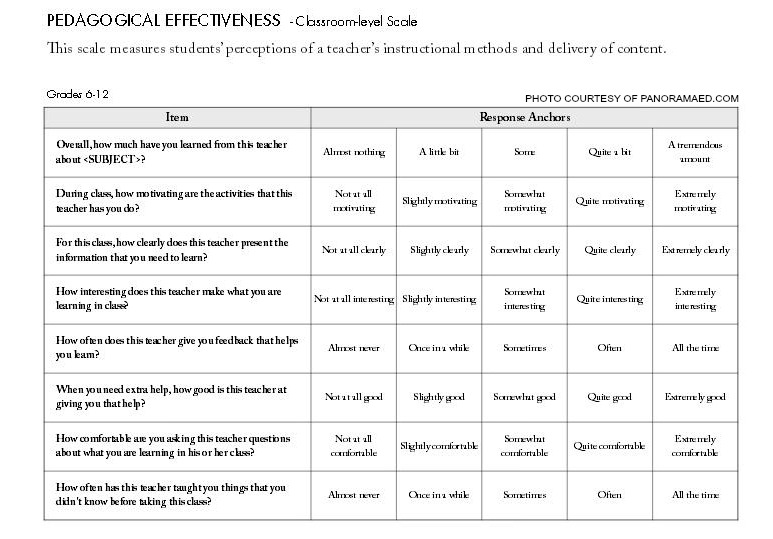
In understanding a student’s true potential, educators only scratch the surface through standardized testing. It’s somewhat understandable why students are graded in this fashion, but how should teachers be graded?
While the method of student assessment is still an important debate, something that deserves a bit more attention is the assessment of teachers. According to The Pew Charitable Trusts, teachers are normally evaluated through random observations and their student’s test scores. However, just as standardized test scores are an inaccurate representation of a student’s knowledge, these evaluation methods are usually inaccurate of how well a teacher performs in class.
According to an article from the New York Times, some of the U.S.’s largest school districts have started implementing student surveys created by Panorama Education, a tech startup run by two young Yale graduates. Panorama Education claims that their surveys are a reliable tool to “measure student perceptions of teaching and learning.”
Anyone is able to freely download a sample of the survey from Panorama Education’s website. It asks questions that cover an important range of categories. These categories include pedagogical (teacher) effectiveness, classroom environment, expectations/rigor, student engagement, supportive relationships, sense of belonging, interest in subject and grit. Each category has around 5 questions with answer choices that range from “very false” to “very true.” These surveys not only evaluate teacher effectiveness, but the effectiveness of students as well.
There are a lot of benefits to conducting surveys like this. In the NY Times article, author Farhad Manjoo mentions the survey experience Leila Campbell, a humanities teacher at a charter school in California, had. Through the survey results, she found that because she was a white teacher in a primarily urban area, her students had a harder time connecting with her and usually didn’t feel comfortable asking questions. Campbell used this feedback to improve her communication. Now, she claims, “I do a presentation where I open up to them, making myself vulnerable about my college experience, and telling them why I’m working with them.”
Just like any kind of assessment though, there is still room for inaccuracy and bias. As Trey Ferguson, Leesville math teacher, pointed out in his e-mail interview, these surveys can be problematic because “you have extreme cases (students that love you, and hate you).” On a more humorous note, he added, “I can only see this type of application becoming an ‘Educational’ Yik Yak.”
Because of Ferguson’s concerns and others like it, Panorama Education has tried to create their surveys in a way that evaluates teachers fairly. Take the multitude of categories, for example. In an EdSurge opinion article by Aaron Feuer, the CEO of Panorama Education, Feuer explains, “Surveying across all of these scales ensures that districts collect a broad enough set of data to evaluate teachers fairly.” As he states in his article, if the survey only asked questions about subject-related things, the information might be biased because particular students may feel extremely negatively or positively towards the subject. But, because the surveys cover so much territory, there’s more information to accurately evaluate teachers. Still, some argue that this standardized method of feedback isn’t necessarily in a school’s best interest.
Robert Phillips, English teacher, feels that teacher evaluation should continue to be an in-school process involving administrators, as “adding another layer of corporate interference in the classroom is [not] the answer to improving student outcomes.”
What could be beneficial, though, are more teacher made surveys and possibly feedback from other teachers rather than administrators. Regardless of who’s observing, Ferguson, Phillips and Robert Thornhill, science teacher, all agree that teacher surveys, in addition to observation feedback, are fulfilling as far as improving themselves each year.
“I love surveys,” said Thornhill in his interview via e-mail. “I give at least one each quarter to all my classes, and I really enjoy reading them (and often learn a lot from them).”
Ferguson follows a similar tradition, stating, “I give students mid-year and end-of-the year course evaluations that does the job for me and my instruction.”
Overall, teachers themselves are more fit than anyone to determine what extra feedback will benefit them the most. Yes, classroom observations and the evaluation of student test scores may be mandatory, but whether or not teachers decide to take it a step further through surveys should be up to them. The survey methodology behind Panorama Education may work for some, but should continue to remain optional.
This article has a lot of amazing information. Another way to give surveys to the students would be by using SALG. The Student Assessment of their Learning Gains (SALG) is a web-based program that allows the teachers to address certain activities or aspects of the class he or she would like to know.